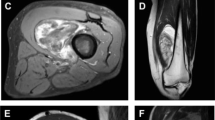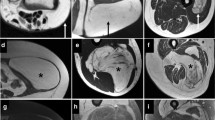Abstract
Objective
To determine the fat content of myxoid liposarcomas (MLS) on MRI and to identify any association between lipid content and survival.
Materials and methods
The fat percentage of MLS diagnosed between January 2006 and December 2016 at a single institution was assessed by two radiologists on preoperative MR images. A Cox proportional hazard model was used to determine any association between tumor fat percentage and survival time. Tumor fat percentage was the single predictor in the model. A significance level of 0.05 was used. The Kaplan–Meier estimator was also used to provide a nonparametric estimate of the survivor function within the entire sample and within two patient subgroups consists of lipid-rich and lipid-poor tumors. Lipid-rich tumors were defined as any tumors showing more than 20% of fat on MRI. A 20% cutoff was determined arbitrarily.
Results
Of the 43 cases identified through retrospective review, 8 tumors demonstrated ≥10% fat on MRI, and 4 tumors demonstrated ≥20% fat (highest fat percentage, 38%). There was no significant survival difference between patients with high tumor fat, which was defined as ≥20% fat, compared with those with little to no tumor fat.
Conclusion
Myxoid liposarcomas may demonstrate a higher fat content on MRI than has previously been reported in the literature. Increased tumor fat percentage in lipid-rich tumors was not found to be associated with increased risk of death. Radiologists must be aware of the existence of MLS lesions with higher fat content.






Similar content being viewed by others
Abbreviations
- MLS:
-
Myxoid liposarcoma
- WDL:
-
Well-differentiated liposarcoma
- ALT:
-
Atypical lipomatous tumor
References
Crago AM, Brennan MF. Principles in management of soft tissue sarcoma. Adv Surg. 2015;49(1):107.
Evans HL. Liposarcoma A study of 55 cases with a reassessment of its classification. Am J Surg Pathol. 1979;3(6):507–24.
Fletcher C, Bridge J, Hogendoorn P, Mertens F. WHO classification of tumours of soft tissue and bone. Pathology and genetics of tumours of soft tissue and bone. 4th ed. Lyon: ARC Press; 2013.
Jo VY, Fletcher CD. WHO classification of soft tissue tumours: an update based on the 2013 (4th) edition. Pathology. 2014;46(2):95–104.
Fritchie KJ, Goldblum JR, Tubbs RR, Sun Y, Carver P, Billings SD, et al. The expanded histologic spectrum of myxoid liposarcoma with an emphasis on newly described patterns: implications for diagnosis on small biopsy specimens. Am J Clin Pathol. 2012;137(2):229–39.
Miettinen M. Diagnostic soft tissue pathology. Diagn Cytopathol. 2005;33(2):140.
Petscavage-Thomas JM, Walker EA, Logie CI, Clarke LE, Duryea DM, Murphey MD. Soft-tissue myxomatous lesions: review of salient imaging features with pathologic comparison. Radiographics. 2014;34(4):964–80.
Alaggio R, Coffin CM, Weiss SW, Bridge JA, Issakov J, Oliveira AM, et al. Liposarcomas in young patients: a study of 82 cases occurring in patients younger than 22 years of age. Am J Surg Pathol. 2009;33(5):645–58.
Mentzel T, Fletcher CD. Dedifferentiated myxoid liposarcoma: a clinicopathological study suggesting a closer relationship between myxoid and well-differentiated liposarcoma. Histopathology. 1997;30(5):457–63.
Murphey MD, Flemming DJ, Jelinek JS, Temple HT, Levine A, Torop AH. Imaging of higher grade liposarcoma with pathologic correlation. Radiology; 1997;205:813–813.
Jelinek JS, Kransdorf MJ, Shmookler BM, Aboulafia AJ, Malawer MM. Liposarcoma of the extremities: MR and CT findings in the histologic subtypes. Radiology. 1993;186(2):455–9.
Sung MS, Kang HS, Suh JS, Lee JH, Park JM, Kim JY, et al. Myxoid liposarcoma: appearance at MR imaging with histologic correlation. Radiographics. 2000;20(4):1007–19.
Van Vliet M, Kliffen M, Krestin GP, van Dijke CF. Soft tissue sarcomas at a glance: clinical, histological, and MR imaging features of malignant extremity soft tissue tumors. Eur Radiol. 2009;19(6):1499–511.
Crago AM, Dickson MA. Liposarcoma: multimodality management and future targeted therapies. Surg Oncol Clin N Am. 2016;25(4):761–73.
Murphey MD, Arcara LK, Fanburg-Smith J. From the archives of the AFIP: imaging of musculoskeletal liposarcoma with radiologic-pathologic correlation. Radiographics. 2005;25(5):1371–95.
Baheti AD, Tirumani SH, Rosenthal MH, Howard SA, Shinagare AB, Ramaiya NH, et al. Myxoid soft-tissue neoplasms: comprehensive update of the taxonomy and MRI features. AJR Am J Roentgenol. 2015;204(2):374–85.
Tateishi U, Hasegawa T, Beppu Y, Kawai A, Satake M, Moriyama N. Prognostic significance of MRI findings in patients with myxoid–round cell liposarcoma. Am J Roentgenol. 2004;182(3):725–31.
Peterson JJ, Kransdorf MJ, Bancroft LW, O’Connor MI. Malignant fatty tumors: classification, clinical course, imaging appearance and treatment. Skeletal Radiol. 2003;32(9):493–503.
Lowenthal D, Zeile M, Niederhagen M, Fehlberg S, Schnapauff D, Pink D, et al. Differentiation of myxoid liposarcoma by magnetic resonance imaging: a histopathologic correlation. Acta Radiol. 2014;55(8):952–60.
Author information
Authors and Affiliations
Corresponding author
Ethics declarations
Conflicts of interest
The authors declare that they have no conflicts of interest.
Rights and permissions
About this article
Cite this article
Kuyumcu, G., Rubin, B.P., Bullen, J. et al. Quantification of fat content in lipid-rich myxoid liposarcomas with MRI: a single-center experience with survival analysis. Skeletal Radiol 47, 1411–1417 (2018). https://doi.org/10.1007/s00256-018-2974-9
Received:
Revised:
Accepted:
Published:
Issue Date:
DOI: https://doi.org/10.1007/s00256-018-2974-9




